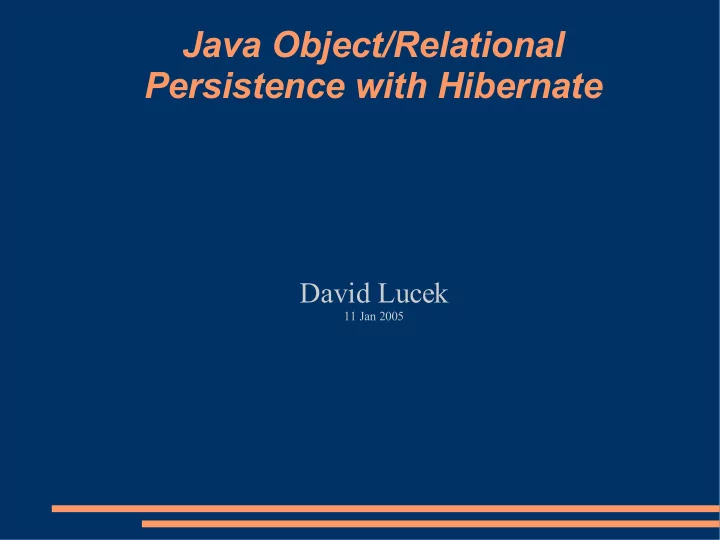

Java Object/Relational Persistence with Hibernate David Lucek 11 Jan 2005
Object Relational Persistence ● Maps objects in your Model to a datastore, normally a relational database. ● Why? – EJB Container Managed Persistence (CMP) is Dead. – The business logic and domain are normally represented as an object model. – The developer should concentrate and work with the object model – Persistence code is complex to write in-house – Java types vs SQL datatype mismatch – Java Collections versus SQL Joins
Object Relational Mapping (ORM) Tools – A good ORM tools should provide ● Transparent Persistence ● Transitive Persistence ● Automatic dirty checking ● Support for Inheritance ● Efficient fetching and caching – Transparent Persistence means any class can be persisted without: ● Any implementation of specific interfaces ● No required persistence superclass – A good ORM should be able to be run outside of a container. Good for testing.
Popular Object Relational Mapping Tools ● TopLink, Oracle Tool ● JDO, POJO persistence, – Official POJO persistence standard – Kodo JDO from SolarMetric is popular – There are many JDO vendors ● Castor – Open Source ● Hibernate – Open Source ● EJB 3.0 will support POJO, probably too late?
The Transparent Persistence Goal ● The goal is to write a POJO and let a toolkit provide the persistence. – We are not there yet, but close ● JDO and Hibernate provide transparent persistence ● They are competing toolkits in base functionality – Hibernate at this point has more advanced query capability and raw SQL support. – But, the JDO 2.0 Spec is coming out soon, which addresses these concerns
Why Hibernate ● Its Open Source (LGPL) ● Mature toolkit, supported by JBoss ● Very popular ● Web Site: www.hibernate.org ● Latest Stable Version: 2.1.7 ● Hibernate 3.0 Beta coming out soon. ● Lots of resources on the web
Main Hibernate Features ● POJO persistence ● Support for fine grained objects ● Flexible Mapping (table to object mapping) ● Two layer Cache Architecture ● Support for Detached Objects ● High Performance Queries ● Eclipse IDE Plug-in ● Round trip toolkits ● 3 Query Options
Basic Hibernate Usage Work Flow 1)Create Java Object Model 2)Create mapping file, hibernate.cfg.xml 1)Mappings POJO to a SQL Table 2)Add your JDBC connection settings here or in a separate hibernate.properties file 3)Use the persistence manager API to save/delete or update your object. ● XDoclet Tags and Ant can be used to automate. This is the most common approach
Basic Hibernate POJO ● Must use JavaBean Specification with Accessor methods ● No-arg Constructor ● Collections must use an Interface ● Add XDoclet tags to “get” methods for persistence. ● Add class level tag for table name. ● Can use sequence, either from database or Hibernate generated.
POJO Example /** * @hibernate.class table="dvds" */ public class DVD implements Serializable { private Long id; private String title; private int type; private Account account; // Parent Object Dvds() {} /** * @hibernate.id generator-class="sequence" type="long" column="id" * @hibernate.generatorParam name="sequence" value="dvdseq" */ public Long getId() { return this.id; } /** * @hibernate.property column="title" */ public String getTitle() { return this.title; } /** @hibernate.property column="type" */ public int getType() { return this.type; } }
Example Mapping Document <hibernate-mapping> <class name="DVD" table="dvds"> <id name="id" column="id" type="long" > <generator class="sequence"/> <param name="sequence">dvdseq</param> </generator> </id> <property name="title" column="title" type="string" length="15" not-null="true"/> <property name="type" column="type" type="short" not- null="true"/> </class> </hibernate-mapping>
Persistence API Usage ● API Order – Get Session – Begin Transaction – Save your object by calling save(), saveOrUpdate() – Commit and close transaction ● Normally this should be wrapped in a DAO layer
API Usage Example - Saving // Create business Object DVD dvd = new DVD(); dvd.setTitle(“Shrek 2”); dvd.setType(1); // Single layer Session session = getSessionFactory().openSession(); Transaction txt = session.BeginTransaction(); // Saves Object to database session.save(dvd); tx.commit(); session.close();
API Usage – Loading/Retrieving ● Can load by Key or Query. ● Loading by Key: Long id = xxx; DVD dvd = session.get(DVD.class,id); ● Hibernate Query Language (HQL) – Native Hibernate Language – Can also use native SQL if desired List dvdsList = session.find(“from DVD”); // Walk through list as required
Hibernate Associations ● Defines relationships in the object model ● Relationship are automatically saved. (Transitive Persistence) ● Example: An Account can have many DVDs An Account can have 1.. * DVDs
Association Example class Account { private Long id; private Set dvds = new HashSet(); Account() {} public Set getDvds() { return this.dvds; } public addDvd(DVD dvd) { // Set the Parent Reference dvd.setAccount(this); // Add to list dvds.add(dvd): } }
Association Mappings ● Account Mapping <class name=”Account” table=”account” > .... <set name=”dvds”> <key column=”id” /> <one-to-many class=”DVD” /> </set> </class> ● DVD Mapping <class name=”DVD” table=”dvds” > .... .... <many-to-one name=account” column=”account” class =”Account” not-null=”true” /> </class>
API Example of Transitive Persistence DVD dvd = new DVD(); dvd.setTitle(“Kill Bill”); Transaction tx = session.getTransaction(); Long id = xxx; Account acct = (Account) session.get(Account.class,id); acct.addDvd(dvd); // This will auto-magically save the DVD object. tx.commit(); session.close();
Hibernate Query's ● Three types 1) Hibernate Query Language (HQL) • Object orientated version of SQL • Has full support for inner/outer joins • Support for aggregation and grouping • Supports sub queries 2)Criteria queries (QBC) Allows creation and execution of object orientated criteria queries. 3) SQL queries • Direct SQL pass through to the database • Can name the SQL queries in the meta data
Other Hibernate Features ● Detached Objects – Get an object, close database Session – Serialize Object to Web Tier – Web Tier sends back the Object and it is reattached to it parent and saved. – Eliminates DTOs ● Automatic Versioning – Provides optimistic locking based on timestamp or number.
Recommend
More recommend